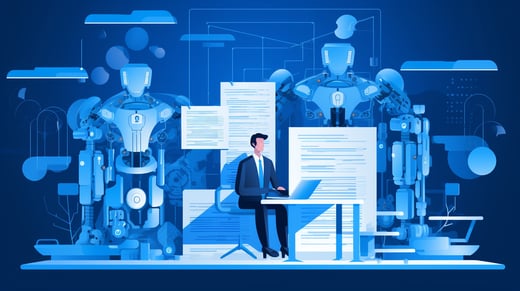As seen in Artificial Lawyer - written by Tim Pullan
We are on the cusp of a revolution. Contract negotiation, with all the associated document redlines and email threads, is about to get a whole lot quicker. Today, artificial intelligence has the potential to save lawyers hours of intense editing – but only if they embrace the sector-wide behaviour change this could ignite.
Currently, lawyers spend a huge amount of time redlining a document. A contract arrives in their inbox to review, the work begins and ‘track changes’ is turned on. The lawyer gets stuck into the detail and hours later sends the static document back across the ether. The wait begins – will changes be accepted, rejected, or begin a trail of debates in floating comment boxes?
All those edits are hiding what’s really important. Is it essential to negotiate each turn of phrase, or use of grammar, whether it has a legal implication or not? The salient negotiation points are easy to lose in a sea of redlines that could highlight very minor points. Each redline sparks a separate conversation, many of which are unnecessary.
This process continues through many iterations. The final document can be hard to determine amid all the colour and it can be difficult to track who has made which change or comment.
It doesn’t have to be this way. Technology has reached the point that much of the initial legwork of perusing a contract can be done by a piece of software. Precision AI can scan a document and create a list of issues based on how a lawyer typically contracts. It is then up to the lawyer to accept or disregard those issues, but the point is that the initial editing time is greatly reduced.
This type of technological innovation has already turned many business practices around. Slack quietly revolutionised how teams communicate, taking away the need for lengthy email chains. Google Docs have allowed people to collaborate on a live document. Microsoft first introduced digital red and blue lines to spot common typing errors. In many sectors, AI is radically speeding up how things can happen, while improving accuracy.
This is all clever technology, but the most interesting aspect of all these solutions is how they can fundamentally improve how we carry out business. In the case of contract negotiation, while technology won’t replace the need for lawyers, it can be a tool to create streamlined, more effective processes.
For example, using highly precise AI to create a digital issues list to negotiate around removes the temptation to amend all the small details. It won’t affect the outcome of the contract negotiation process whether a phrase used by one lawyer differs from that used by another. But when redlining, the temptation to amend a sentence will always prove too strong.
By only focusing on the relevant points, discussions are sharpened. This not only reduces initial review time, but also reduces the time spent on back-and-forth discussions to finalise the contract.
Secondly, the contract remains clear. When redlining, it only takes two or three exchanges for a document to become incomprehensible. Amendments are made on top of amendments with no clear way to track their order. Using a digital issues list creates a record that provides clarity to all parties.
Thirdly, using a digital issues list leaves the issue open for discussion. When a lawyer has agreed to use a counterparty’s terms, there should be an implicit bargain: while the receiving lawyer will review the contract, it is the counterparty’s primary responsibility to make changes. The benefit here is clarity; one person acting as editor.
If they do so in bad faith, which rarely happens, the process will break down, but otherwise opportunities can be created. By simply raising an issue, rather than rewriting a contract, a space is left for the other party to suggest a solution. It opens a dialogue, and you might find that the other side comes back with something even better.
Overall, issues-based negotiation supported by a digital issues list leads to improved negotiating relationships. The process is less adversarial. There is space to become a better negotiator by making decisions about what is important and what is not.
We have put this theory into action. ThoughtRiver’s law firm clients and partners are recognising the benefits of the AI-assisted contract review we provide during the pre-execution negotiation phase.
‘ThoughtRiver’s technology answers a need for innovative technology that we and our clients have been searching for,’ said IT contracting partner Chanley Howell with Foley & Lardner, LLP. ‘We use it to drive efficiencies and quality control in our Foley Equipped service. It allows our lawyers and clients to leverage AI-powered issues lists with built-in and customized playbook advice, and model contract language.’
‘We use it to drive efficiencies and quality control in our Foley Equipped service. It allows our lawyers and clients to leverage AI-powered issues lists with built-in and customized playbook advice, and model contract language.’
Chanley Howell, Foley & Lardner, LLP
We want to start a movement of people like Chanley who take this new, AI-powered approach to contract negotiation. The whole idea of responding with an issues list isn’t alien, but is traditionally time-consuming. People resort to redline because it feels quicker than adding a comment to a document that you need to create for each review. We are seeking to build a community of people who are enlightened to take a different approach.
If the revolution is successful, reviewing an 80-page contract for the first time could take less than an hour, instead of five. Reviewing a standard NDA could take 5 minutes instead of 20 minutes. That is a huge improvement in time efficiency. On top of that, you don’t need to use a single redline.
This technology is not going to replace the role of lawyers. While it is accurate – ThoughtRiver’s technology is 97% accurate to be precise – a lawyer will still need to pick out the salient points. The negotiation relationship is created by the lawyer; technology cannot do that. What we’re doing is offering a more efficient, accurate way of doing things.
Lawyers want to be able to find clarity in a sea of words they’re drowning in. This is one way to get to the right outcome – a signed contract – far more effectively.



